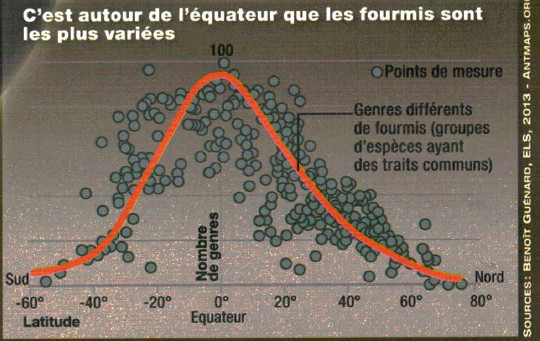
Répartition des fourmis dans le monde
Alain Lenoir Mis à jour 11-Mai-2025

Pour avoir une idée de la répartition des fourmis dans le monde il faut aller voir :
- Où y a t-il le plus de fourmis à découvrir ? Voir Kass et al 2022.
- sur antweb
qui répertorie toutes les fourmis connues dans le monde, par l'académie
des Sciences de Californie. AntWeb focuses on specimen level data and images
linked to specimens. In addition, contributors can submit natural history information
and field images that are linked directly to taxonomic names. Distribution maps
and field guides are generated automatically. All data in AntWeb are downloadable
by users. AntWeb also provides specimen-level data, images, and natural history
content to the Global Biodiversity Information Facility (GBIF), the Encyclopedia
of Life (EOL.org), and Wikipedia.
Au 12 novembre 2019 il y a 16 239 espèces valides.
- sur antmaps.org
Global Ant Biodiversity Informatics pour la répartition des espèces
connues. The Global Ant Biodiversity Informatics (GABI) project aims to
compile 250 years of ant research into a single database providing distribution
information for all ant species. With this project we hope to offer new opportunities
to address questions in macroecology, macroevolution and biogeography of Formicidae
as well as provide new insights for the use of distribution data for ant taxonomy,
species inventories and conservation. At this time, records from > 8800 publications
and 25 pre-existing databases have been compiled for a total of > 1.7 M records.
Voir
Benoît Guénard
Voir Les
fourmis ont désormais leur atlas mondial (Science et Vie, novembre
2015). Elles sont partout sauf aux pôles.

Des
zones plus limitées (en fonction des publications récentes)
Algérie :
- Amara,
Y., H. Tliba, B. Farid and S. Daoudi-Hacini (2020). Diversity, Richness and
Composition of Ant Communities (Hymenoptera: Formicidae) in the Pre-Saharan
Steppe of Algeria. Sociobiology 67: 48. doi: 10.13102/sociobiology.v67i1.2897.
Brésil : une revue de 40 auteurs sur 50 ans de recherches. On a trouvé 1130 espèces, la forêt amazonienne est la plus riche avec 716 espèces, ensuite la forêt atlantique avec 657 espèces, le Cerrardo (389), la Caatinga (185), le Pantanal 143) et la Pampa (86). Les genres Azteca, Hypoponera, Pheidole, et Solenopsis sont très mal connus. Les auteurs soulignent que près de 10% des études comportent des erreurs d'identification ou de localisation (Feitosa et al 2022).
Un
nouveau magazine sur internet
"Passion
Entomolologie"
A
propos de la découverte de deux espèces nouvelles de fourmis en
Nouvelle-Calédonie. Par Thibault Ramage & Corentin Jouault (6juillet
2020)
Réf
-
Feitosa, R. M., G. P. Camacho, T. S. R. Silva, M. A. Ulysséa, N. Ladino,
A. M. Oliveira, E. Z. Albuquerque, F. A. Schmidt, C. R. Ribas, A. Nogueira,
F. B. Baccaro, A. C. M. Queiroz, W. Dáttilo, R. R. Silva, J. C. Santos,
A. M. Rabello, M. S. D. C. Morini, Y. P. Quinet, K. Del-Claro, A. Y. Harada,
K. S. Carvalho, T. G. Sobrinho, A. B. Moraes, A. B. Vargas, H. M. Torezan-Silingardi,
J. L. P. Souza, T. Marques, T. Izzo, D. Lange, I. A. Santos, L. Nahas, L. Paolucci,
S. A. Soares, C. B. Costa-Milanez, E. Diehl-Fleig, R. B. F. Campos, R. Solar,
T. Frizzo and W. Darocha (2022). Ants of Brazil: an overview based on 50 years
of diversity studies. Systematics and Biodiversity 20(1): 2089268. doi: 10.1080/14772000.2022.2089268.
(article sous embargo)
- Kass, J. M., B.
Guénard, K. L. Dudley, C. N. Jenkins, F. Azuma, B. L. Fisher, C.
L. Parr, H. Gibb, J. T. Longino, P. S. Ward, A. Chao, D. Lubertazzi, M. Weiser,
W. Jetz, R. Guralnick, R.
Blatrix, J. D. Lauriers, D. A. Donoso, C. Georgiadis, K. Gomez, P. G. Hawkes,
R. A. Johnson, J. E. Lattke, J. A. MacGown, W. Mackay, S. Robson, N. J. Sanders,
R. R. Dunn and E. P. Economo (2022). The global distribution of known and undiscovered
ant biodiversity. Science Advances 8(31): eabp9908. doi: doi:10.1126/sciadv.abp9908.
- Interviews
- The first high-resolution global map of ant biodiversity and estimates of
where future sampling could yield undiscovered species, by Myrmecological
News Blog 21 September 2022 .